Discover 7 hidden attractions, cool sights, and unusual things to do in Büdingen (Germany). Don't miss out on these must-see attractions: Witch Tower, Großes Bollwerk, and Steinernes Haus. Also, be sure to include Schlaghaus in your itinerary.
Below, you can find the list of the most amazing places you should visit in Büdingen (Hesse).
Table of Contents
Witch Tower
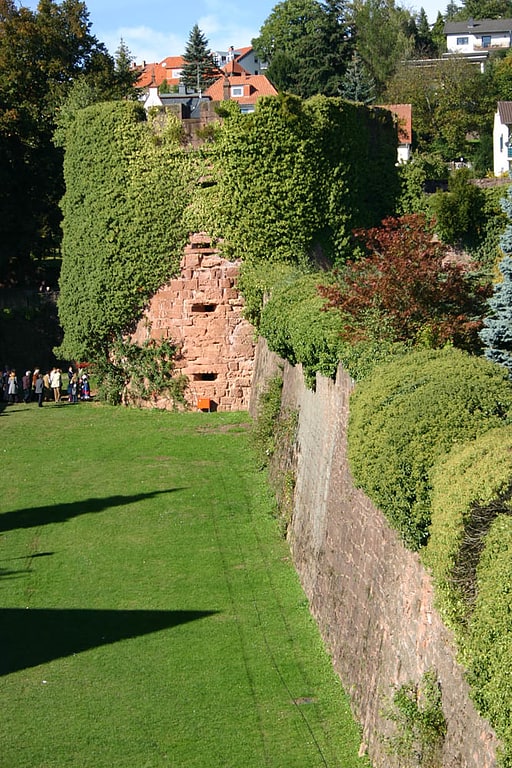
Also known as: Hexenturm
The Great Bulwark is the strongest medieval tower structure in the town of Büdingen in Hesse. It is located at the northwest corner of the fortification. The Witches' Tower is connected to the Great Bulwark by casemates.
Großes Bollwerk
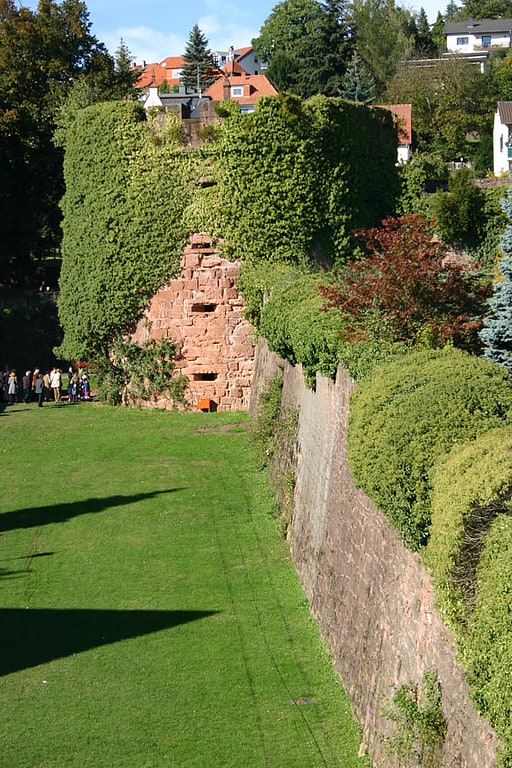
The Great Bulwark is the strongest medieval tower structure in the town of Büdingen in Hesse. It is located at the northwest corner of the fortification. The Witches' Tower is connected to the Great Bulwark by casemates.
Steinernes Haus
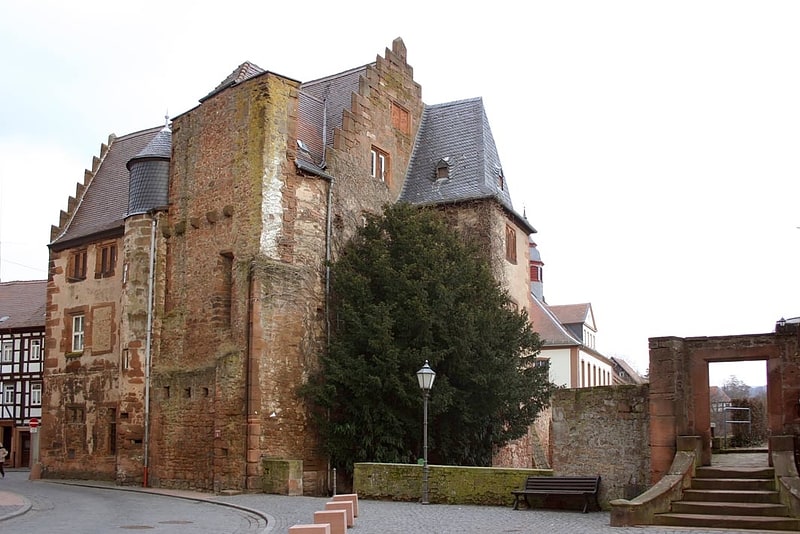
The Stone House is the oldest residential building in the Hessian town of Büdingen, which was built entirely in stone. The late Gothic building was erected before 1500 as a town residence for Count Johann zu Isenburg. With its castle-like wall, the house had the task of securing the important bridgehead at the Mühltor. Its imposing front with high stepped gables forms a striking closure to the Altstadtstraße. The late Gothic oriel with fish-bubble tracery, which was added in 1544 and rests on a pointed console, was given its pointed roof termination again in 1998. In the oriel room there is a valuable stucco ceiling.
Noteworthy are the fortifications, which were connected to the "Mühlpforte" via battlements. In the courtyard there is also a well from 1544. The water emergency marks on the inner gate cheeks impressively document the problems of the old town of Büdingen with floods. Worth mentioning are the hunchback embrasures in the old town wall. Next to the main gate is a legendary stuffed boar's head.
As a component of the overall complex of Büdingen's old town, the Stone House is subject to protection under the Hague Convention for the Protection of Cultural Property in the Event of Armed Conflict.
Schlaghaus
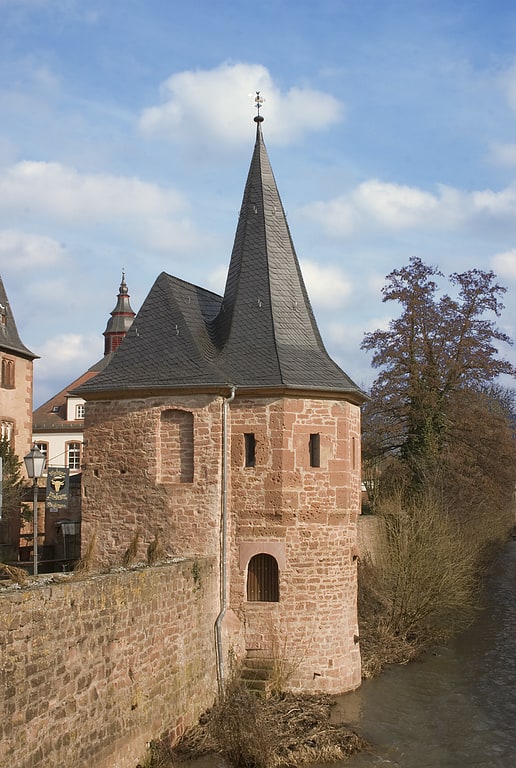
The Schlaghaus in Büdingen is a massive late medieval gatehouse built at the beginning of the 14th century. Originally, the Schlaghaus was located on the most vulnerable southern side of the old town on the far bank of the Seemenbach, counterpart of the high mill gate and connected with a drawbridge. The army and trade road passed by there, which required special protection. In the great "Freiheitsbrief" (Letter of Freedom), with which Heinrich II, Lord of Büdingen, gifted his town in 1353, the gate complex with bridge, bars, drawbridge and tollgate is described.
The term blow house is derived from blow. The term has various meanings. It can mean a portcullis or a kind of barrier to protect the bridge system. Schlag also refers to batter walls, which were often built in front of gates in the Middle Ages to divert the attacking enemy away from the direct direction to the gate. Schlag also refers to the place where tolls or tolls had to be paid, the Schlagbaum.
Initially, the Mühlpforte and the Schlaghaus were in a straight line. In the event of enemy attacks, not only the Schlaghaus but also the second gate was at risk from gunfire. With the construction of a mighty wall belt in front of the older city wall between 1480 and 1510 by Count Ludwig II, this weakness was eliminated in 1494 by a redesign of the gate system. The course of the Seemenbach was diverted to the south in front of the "Damm" and the old stream bed was converted into a dry ditch. As an outer gate, the Mühltor near Meliorschen Haus was built further to the west. The S-shaped routing thus prevented the passage of bullets through both gates. This meant that the Schlaghaus also lost its significance as a gate building and was converted into a half-tower of the new fortification. The passage of the gatehouse was walled up and a small tower with a pointed roof was placed in front of the Seemenbach. From the turret it was possible to effectively fire at the stream, the gate bridge and the forecourt. Three of the hump embrasures (firing openings) typical of Büdingen are present on each of two levels. The upper floor served as an escape and guardroom. The military importance is still evidenced by lead bullet bullet holes on the outside during the siege in the fall of 1634. Since 1700, the defensive structure with its walls and towers became less and less important. Thus, the Schlaghaus was used as a "Betzenloch", a prison for minor offenses. Dated carvings inside remind us of this function. It also served as a detention center for the gate guards.
Until 1777, the Metzgerschirn on the Küchenbach served the Büdingen butchers as a slaughterhouse. In that year, the butchers moved their trade to the Schlaghaus, which thus received its further name Schlachthaus (slaughterhouse). For this purpose, the basement of the tower was filled in and the embrasures there were bricked up. Sandstone slabs with a slight slope were laid on the floor of the slaughter room thus created. This made it possible to channel blood and slaughter waste directly into the Seemenbach stream. The slaughter room was equipped with a slaughter beam and other equipment.
In 1892, district health physician Dr. Hauser criticized the conditions in the Büdingen slaughterhouse. At times, the Seemenbach carried only little water or was dammed up by the millers. As a result, the Seemenbach was often unable to fulfill its function as a sewer. In addition, the entire slaughtering process took place in public, since there was no closable area around the slaughterhouse. The slaughtered livestock was often transported without a cover. Finally, in 1895, the butchers of Büdingen founded the slaughterhouse cooperative. The object of their enterprise was the "construction of a slaughterhouse in Büdingen for joint account". The new slaughterhouse was built quickly and was soon able to take over the function of the slaughterhouse.
For more than 100 years, the loft served as a storage room, most recently for the municipal building yard. As part of the renovation of the old town, the tower was thoroughly renovated in 2005/2006. In the process, the basement of the loft house was uncovered and made visible under a grating. Since September 2006, on the initiative of the slaughterhouse cooperative, the Schlaghaus has housed the Büdingen Butcher Museum. The slaughtering equipment with slaughtering beams and winch were reinstalled for this purpose. Historical butcher's tools and machines are also on display.
Wilder Stein
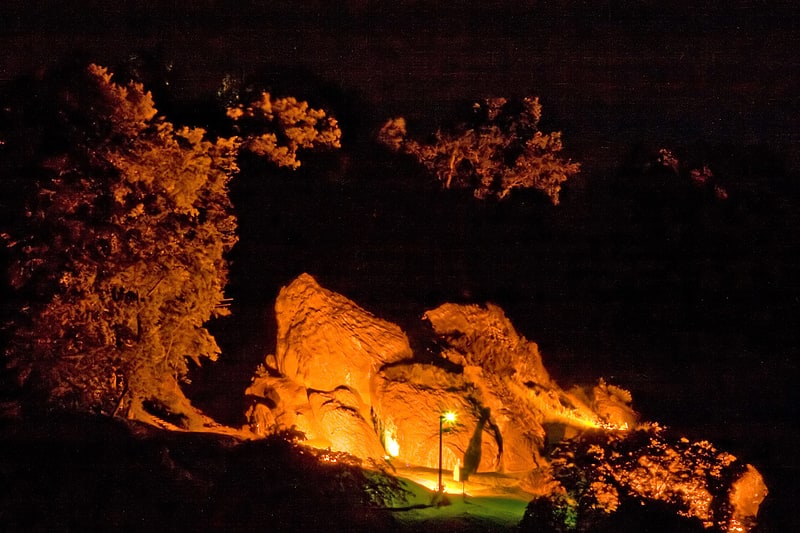
The "Wilde Stein" in Büdingen is a striking and rare geotope consisting of columnar basalt. It was formed as a side vent of the Vogelsberg volcano.
Address: Am WildenStein, Büdingen
Oberhof
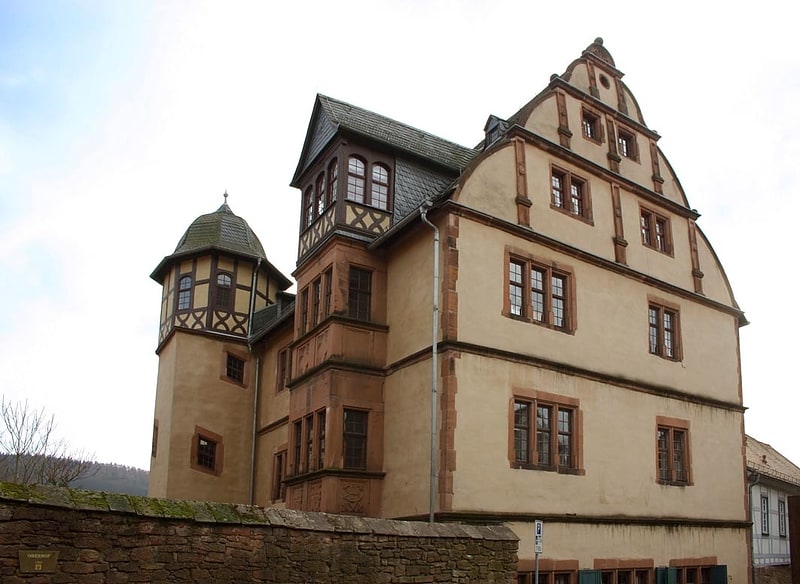
The Oberhof, built in 1569/70 is a Renaissance building in the town of Büdingen. Originally, the courtyard complex comprising several building parts was built by Count Georg zu Ysenburg and Barbara Countess von Wertheim by the Franconian master builder Conrad Leonhard. The building served the Ysenburg family for generations as a residence and widow's residence. As part of the overall complex of the old town of Büdingen, the courtyard is a protected cultural asset in accordance with the Hague Convention for the Protection of Cultural Property in the Event of Armed Conflict.
Many details of the residential building are of interest: On the window walls there are stonemason's marks. On the north side in the direction of "Obergasse" building inscriptions are still visible. On the south gable, remains of the exterior painting (Noah's Ark) are recognizable. The entrance with its carved wooden door is framed by the coat of arms decorated main portal, the eastern bay is decorated by antique figures ("fright heads").
In 1959, the town of Büdingen took over the Oberhof. The dilapidated property was renovated at a cost of 9 million euros and is now the home of the music and art school. The "Pferdestall" as well as the "Sälchen" are used for various cultural events such as readings, concerts or picture exhibitions.
Public library

Also known as: Stadtbücherei
Library
Address: Eberhard-Bauner-Allee 16, Büdingen